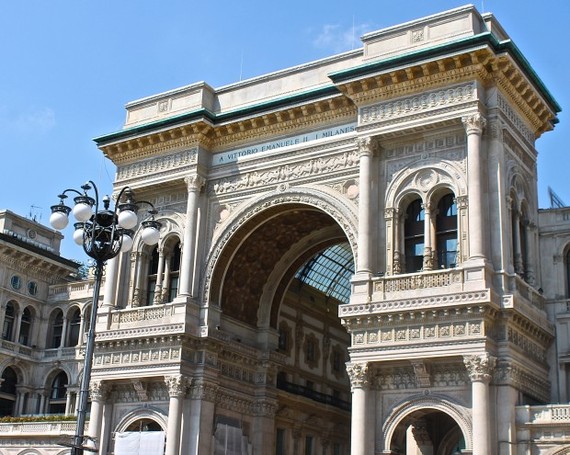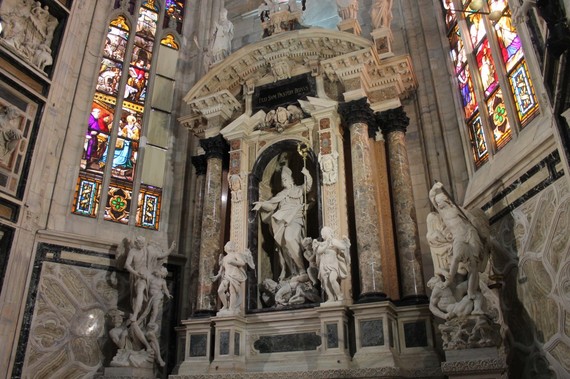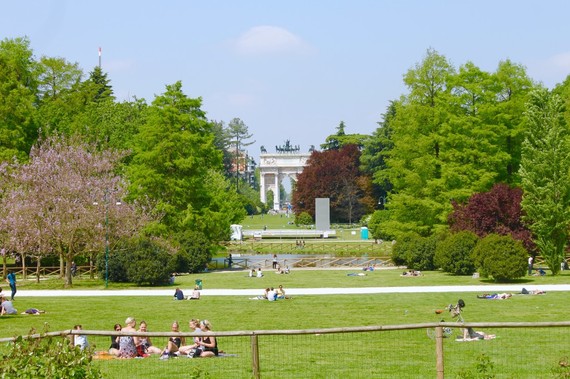This city guide to Milan will making traveling around the famous Italian city more enjoyable.
Milan: home to world renowned designers Giorgio Armani, Valentino Garavani and Gianni Versace, there's no wonder why this city is the global capital of fashion and design. Yet there's so much more to Milan than what its designers create for runways around the world. Italy's stock exchange is based in Milan, making it the country's main financial center. Milan is also seen as Europe's main hub for trade and industrialization. Similar to most Italian cities, foodies flock to Milan to eat dishes from some of the best chefs in the culinary world.
Located in the Lombardy region of Northern Italy, Milan is a vibrant city with a mixture of both ancient and modern influences. Gallic tribes inhabited Milan from 600 BC until it was taken over by the Roman Empire in 222 BC. Decades later, in 292 AD, Mediolanum, the name of ancient Milan, became the capital of the western empire.
In 313 AD, Emperor Constantine granted the edict of Milan, allowing Christians to worship freely. Constantine was also a believer in Christianity, and gave the Church tax-free land and money in order to build more places of worship. Many of these Churches can still be seen in Milan today.
In the 13th century, the city's government was ruled under three dynasty families, the Torrianis, the Viscontis and the Sforzas. Milan fell into Spanish rule in 1535 and then Austrian rule in 1713.
Milan was named the capital of Napolean's Cisalpine Republic in 1797 and in 1802, became a part of the Italian Republic as well.
After World War I in 1919, Mussolini lived and worked in Milan as an editor for a socialist newspaper, where he later established the the Fascist Party. The bombings of World War II greatly destroyed the city. After the war had ended, the city took it as opportunity to expand Milan and make it bigger and better than ever before.
Here's a list of our top 5 things to see in Milan.
1) The World Expo
Milan is hosting this year's World Expo, with the theme "Feeding the Planet, Energy For Life." Exhibitions are based on culinary innovation and food sustainability. When you visit, be sure to arrive on an empty stomach. The best chefs in the business are stationed at various restaurants and food stalls highlighting the best food their country has to offer. The expo opened on May 1st and will be running until October 31st, 2015.
A trip to Milan isn't complete without a visit to the Duomo, the iconic Gothic Cathedral is known for the 2,245 statues decorating its exterior. It's only when you stand beside one of the massive 52 pillars in the sanctuary, each representing one week of the year, that you realize how massive this place of worship really is. Before you leave, remember to keep your eyes out for a red lightbulb up above the altar. This little light marks the spot with a box that's believed to safeguard a nail from Christ's crucifixion.For €12 you can take the elevator up to the roof, where you'll see one of the greatest views in all of the city. Looking to save some cash? Entrance to the stairs to the roof is €7!
3) Leonardo Da Vinci's Last Supper
Pay tribute to one of the world's most famous paintings at the monastery of Santa Maria delle Grazie. Da Vinci painted The Last Supper on the wall of the convent's dining hall. If you want to see this masterpiece, be sure to book tickets as early as possible. In order to ensure that everyone can appreciate the view, groups of only 20 people can look at the painting each time. Each group is allocated 15 minutes of time with one of Da Vinci's most famous works.
4) The Galleria Vittorio Emanuele II
The Galleria Vittorio Emanuele II is one of the oldest shopping malls in the world, and is arguably one of the most beautiful. This inclosed four-story arcade houses stores like Prada, Valentino, and Dolce and Gabbana, which will most likely make a visit to the galleria a window-shopping experience. But we'll definitely be able to afford that Versace purse after graduation, right?
116 acres of open grass, winding paths, and a central pond makes Parco Semipione a favorite place for locals and tourists alike. The park is situated right outside Milan's historic city center and is near the Sforza Castle. For an unbelievable panoramic view of the city, head to the Torre Branca. Another insider's tip: there's free public WIFI throughout the park.
Backstreets
Milan's Borsa
A contest was held in 2009 to find the most fitting statue to decorate the Piazza deli Affari, the square outside of Milan's stock exchange. Local artist, Maurizo Cattelan, won with his 36 foot sculpture of a huge middle finger. The statue represents how the 99 percent supposedly feel like when they're standing in front of the local stock exchange, and other symbols of corporate power. The exhibit was only supposed to be temporary, but the public liked it so much that it's now there permanently.
Chiesa di Santa Maria presso San Satrio
Tourists don't always head to the The Chiesa di Santa Mario presso San Satrio because it's located in a court yard in between local residences, making it easy to miss. Built in the 15th century, this ornate Church is known for its optical perspective, in which a flat wall is painted to look like there's several rows of columns behind the high altar.
Try This
Aperitivo
Aperitivo is a pre-dinner meal that bars typically offer from 6- 9 p.m.. The Milanese love to meet with colleagues and friends to enjoy aperitivio after work. Many bars will offer a wide selection of free food like fresh mozzarella, pasta salads, pizza and a verity of vegetables, which you're welcome to take after ordering a pint of beer or a cocktail. There are a many aperitivo bars in Milan, making it easy to find one that suits your style and budget.
Eat Here
Luini
Located around the corner of the Duomo, right by the the Galleria Vittorio Emmanuel, you'll find a queue of both locals and travellers alike, all waiting to order one of Luini's famous panzerottis. The ten minute queue is definitely worth the wait. I suggest you opt for their classic mozzarella and tomato panzerotti. Once you take a bite, you'll understand why this family business is one of the best places to eat in all of Milan. The half-moon-pastry is filled with cheese that melts in your mouth and dough that's perfectly fluffy and crispy. Each panzerotti costs around €2- 3.
Cioccolati Italiani
Go to Cioccolati Italani for Milan's best gelato. This Italian gelateria is special because your cup or cone is filled with your choice of either dark, milk, or white chocolate before you order your favorite flavors of gelato!
After Dark
Navigli District
End your day by the canal in the Navigli District, a trendy area of the city filled with boutiques, cafes, bars, restaurants and art galleries.
Transportation:
In and around Milan:
Milan is very walkable and going by foot is by far the best way to explore the city's chic neighbourhoods. However, Milan also has an extensive public transportation system with ticket fares comparable to other big cities (€1.50 per journey) . The underground metro is safe, fast and simple to navigate. For those who prefer to stay above ground, the city's busses and iconic trams are your best bet to get you where you need to go.
Getting to Milan:
Budget airline, Ryanair, flies into Bergamo airport. From here, shuttle busses are offered to and from Milan's Centrale station for €5 each way after booking online. There are also trains to Milan from other major cities in Italy such as Florence, Rome, and Venice.
Local Knowledge
- Similar to all big European cities, store your valuables in a safe place and keep your eye out for pickpockets
- Most museums and other tourist destinations are closed on Mondays.
Read more student travel stories at The College Tourist


